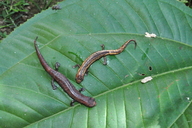|
Bolitoglossa leandrae Acevedo, Wake, Márquez, Silva, Franco & Amézquita, 2013
Leandra salamander, Salamandra de Leandra Subgenus: Eladinea | family: Plethodontidae subfamily: Hemidactyliinae genus: Bolitoglossa |
| Species Description: Acevedo AA, Wake DB, Marquez R, Silva K, Franco R, Amezquita A 2013 Two new species of salamanders, genus Bolitoglossa (Amphibia: Plethodontidae), from the eastern Colombian Andes. Zootaxa 3609: 069-084. | |
 © 2013 Aldemar A. Acevedo (1 of 2) |
|
|
|
Description This species is considered part of the genus Bolitoglossa because of the lack of a sublingual fold, the extensive webbing on their digits, and the number of costal grooves between their limbs. Bolitoglossa leandrae is different from the other South American Bolitoglossa species because of several morphological features. With a maximum known snout-vent length of 39.2 mm, B. leandrea is the smallest species in the Bolitoglossa genus. However, it is not much smaller from the next smallest species, B. altamazonica which has a maximum snout-vent length of 41.2 mm. Bolitoglossa leandrea has more extensive webbing than highland (far more) and mid-land (moderately more) species. Highland species are B. hypacra, B. adspersa, and B. guaramacalensis, and mid-land species are B. tatamae, B. vallecula, B. spongai, B. orestes, B. palmata, B. savagei, B. ramosi, B. capitana, B. nicefori, B. phalarosoma, B. pandi, B. borburata, B. sima, B peruviana, and B. equatoriana. However, B. leandrae has less extensive webbing than the lowland species, B. biseriata, B. lozanoi, B. altamazonica, B. chica, and B. medemi. Compared specifically to B. guaneae, the focal species has a smaller snout-vent length, more digit webbing, and fewer maxillary teeth. Most South American Bolitoglossa species have more maxillary teeth than B. leandrae; the only species that have fewer maxillary teeth are B. adspera, B. orestes, B. altamazonica, B. chica, and B. equatoriana. Bolitoglossa leandrae also have more vomerine teeth (males: 19, females: 20) than B. hiemalis, B. orestes, B. spongai, B. altamazonica, B. sima, B. peruviana and B. lozanoi (Acevedo et al. 2013). Coloration in life and preserved individuals are the same. In males the tail and trunk dorsum are a dark brown color with thin yellow stripes running down the length of the body. On the female, the dorsal surface ranges from a copper-brown to reddish color. The species venter is mostly grey with little brown spots (Acevedo et al. 2013). The number of maxillary teeth in B. leandrae varies by sex, male have 23, and females have 29. There is also a difference in the number of vomerine teeth, which is 19 for males, and 20 for females. This species is sexually dimorphic in size; females are larger (mean snout-vent length = 39.2mm), than males (mean snout-vent length = 30.3mm; Acevedo et al. 2013). Distribution and Habitat Country distribution from AmphibiaWeb's database: Colombia, Venezuela
Life History, Abundance, Activity, and Special Behaviors Trends and Threats While the species has not been evaluated by the IUCN Redlist, according to the known information the species should be classified as “Endangered B2ac (iii)”, following the Red List Category & Criteria because the species is known from fewer than 5 localities (in this case only one locality) that are in a fragmented habitat and that is less than 500 km2. Formal evaluation of their state of conservation is needed so that management protocols can be planned (Acevedo et al. 2013). Possible reasons for amphibian decline General habitat alteration and loss Comments This species belongs to a subclade within the Eladinea clade. Based on Bayesian Inference and Maximum Likelihood analysis of 510 base pair sequence of the 16S rRNA gene, B. leandrae is most closely related to B. nicefori (Acevedo et al. 2013). The species epithet was chosen to honor a local girl named Leandra Mojica, as a representation of the children of the rural area of Tama National Park in San Antonio who showed the researchers great excitement in learning about amphibians (Acevedo et al. 2013). A putative B. altamazonica specimen from Quebrada Doradas, Distrito Uribante, Táchira, Venezuela, 60 km northnortheast of the type locality for B. leandrae may be more closely related to the focal species than the more wide-spread B. altamazonica (Acevedo et al. 2013).
References
Acevedo, A. A., Wake, D. B, Márquez, R., Silva, K., Franco, R., Amézquita, A. (2013). "Two New Species of Salamanders, Genus Bolitoglossa (Amphibia: Plethodontidae), from the Eastern Colombian Andes." Zootaxa, 3609(1), 69-84. [link] Originally submitted by: Valentina Bache-Rodriguez (first posted 2016-12-28) Edited by: Ann T. Chang (2016-12-28) Species Account Citation: AmphibiaWeb 2016 Bolitoglossa leandrae: Leandra salamander <https://amphibiaweb.org/species/7966> University of California, Berkeley, CA, USA. Accessed May 31, 2025.
Feedback or comments about this page.
Citation: AmphibiaWeb. 2025. <https://amphibiaweb.org> University of California, Berkeley, CA, USA. Accessed 31 May 2025. AmphibiaWeb's policy on data use. |



 Raffaëlli Account
Raffaëlli Account Map of Life
Map of Life